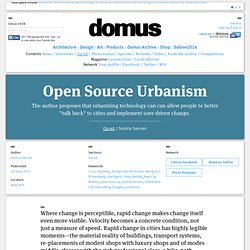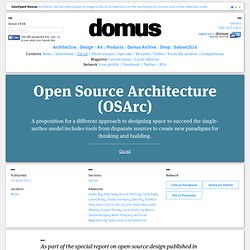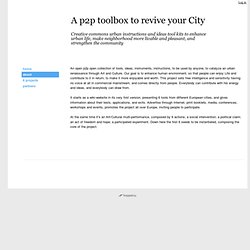

Open-source city: In urban interventions, the metaphor matters. "As digital devices and technological infrastructures increasingly mediate the way we live in cities, the language by which we describe urbanism shifts accordingly.

" The living city. It’s a phrase or a variation on a phrase you’ve probably heard dozens of times to describe the urban realm. Perhaps we use the living descriptor because we like to anthropomorphize evolutionary processes; take Jane Jacobs’s iconic title The Death and Life of Great American Cities as an example. Or maybe it’s because cities are seething with people—the churn of humanity on the streets.
Here, we can look to The Social Life of Small Urban Spaces, William H. In 2008, Matthew Fuller and Usman Haque created the Urban Versioning System 1.0. Urban Field Manuals. “In considering novel urbanisms, it is important not only to investigate new urban processes and kinds of organization, but also to re-evaluate the methodologies by which we intervene in urban systems and spaces.

The traditional tools of the urbanist are the capital project and the contract document; the capital project originates with a major initial capital investment by a party other than the designer (usually either a public agency or a private investor), while contract documents are used to define the terms of production and maintenance of a capital project. Neither of these tools are obsolete in a condition of “editing urbanism”. However, we propose that another, often-ignored tool may be of greater use: the maintenance manual.“ The above excerpt is from the introduction to “Urban field Manuals”, an article we co-authored with Brian Davis of Faslanyc and Rob Holmes of Mammoth for MONU’s current Editing Urbanism Issue.
[Recetas Urbanas' Skip Project] Like this: Like Loading... Embracing Impermanence: Why Some Architecture Should Be Temporary. CUP - Making Policy Public - Current Issues. 1.

The Cargo Chain This poster shows the players and pressure points in today’s globalized shipping network. It was produced through a collaboration with the Longshore Workers Coalition, Labor Notes, cartographer Bill Rankin, and the graphic design office Thumb. 2. Social Security Risk Machine This poster explains the mechanics of this “social machine”: how it works, why it was created, where the money comes from, and where it goes. 3. This poster explains how thousands of affordable housing units were put at risk by private equity investors and how to save them. 4. City Sessions. Archive Fever: A Freudian Impression - Jacques Derrida - Google Books. Tactical Engagements. Open Source Urbanism - Op-Ed. Where change is perceptible, rapid change makes change itself even more visible.

Velocity becomes a concrete condition, not just a measure of speed. Rapid change in cities has highly legible moments—the material reality of buildings, transport systems, re-placements of modest shops with luxury shops and of modes middle-classes with the rich professional class, a bike-path where there was none—and they can be both good and not so good.
Further, when rapid transformation happens simultaneously in several cities with at least some comparable conditions, it also makes visible how diverse the spatial outcomes can be even when the underlying dynamics might be quite similar. All of this brings to the fore the differing degrees of openness of cities. I prefer thinking of this as the incompleteness of cities, which means that they can constantly be remade, for better or for worse. Let me take the imagery of incompleteness further. How can we urbanize the actual technology? THE MAZE CORPORATION. Open Source Architecture (OSArc) - Op-Ed. As part of the special report on open-source design published in issue 948, Domus approached Carlo Ratti to write an op-ed on the theme of open-source architecture.

He responded with an unusual suggestion: why not write it collaboratively, as an open-source document? Within a few hours a page was started on Wikipedia, and an invitation sent to an initial network of contributors. The outcome of this collaborative effort is presented below. The article is a capture of the text as of 11 May 2011, but the Wikipedia page remains online as an open canvas—a 21st-century manifesto of sorts, which by definition is in permanent evolution.The contributors to this article included Paola Antonelli, Adam Bly, Lucas Dietrich, Joseph Grima, Dan Hill, John Habraken, Alex Haw, John Maeda, Nicholas Negroponte, Hans Ulrich Obrist, Carlo Ratti, Casey Reas, Marco Santambrogio, Mark Shepard, Chiara Somajni, Bruce Sterling References — R. P2P toolbox to reviver your City - about. An open p2p open collection of tools, ideas, instruments, instructions, to be used by anyone, to catalyze an urban renaissance through Art and Culture.

Our goal is to enhance human environment, so that people can enjoy Life and contribute to it in return, to make it more enjoyable and worth. This project sets free intelligence and sensitivity having no voice at all in commercial mainstream, and comes directly from people. Design Observer. Mimi Zeiger is editor and publisher of Loud Paper , a zine and blog dedicated to increasing the volume of architectural discourse. As a writer and critic, she covers art, architecture and design for a number of publications including The New York Times , Domus , Dwell , and Architect , where she is a contributing editor. Zeiger is author of Tiny Houses . Writings on cities - Henri Lefebvre, Elizabeth Lebas - Google Books. The situationist city - Simon Sadler - Google Books. Architecture and participation - Peter Blundell-Jones, Doina Petrescu, Jeremy Till - Google Books. Ground-up city: play as a design tool - Liane Lefaivre, George Hall, Döll, atelier voor bouwkunst (Rotterdam) - Google Books.